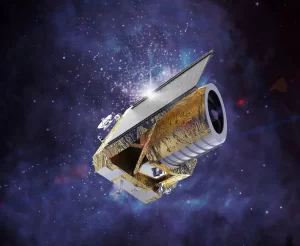Mapping the Dark Cosmos | Euclid’s Pioneering Quest for the Universe’s Hidden Secrets | How Europe’s Euclid Telescope is Unveiling the Invisible Forces Shaping Our Universe
 Europe’s Euclid telescope has embarked on a journey that reads like the prologue to an epic saga—one where humanity ventures into the darkest, most mysterious realms of the cosmos. Designed to probe the unseen forces that govern the universe, Euclid’s mission is not merely about capturing breathtaking images; it is a quest to decipher the enigmas of dark matter and dark energy, which together form an astonishing 95% of the cosmos. This bold endeavor speaks to our insatiable curiosity, blending cutting-edge technology with timeless questions about our origins and destiny.
Europe’s Euclid telescope has embarked on a journey that reads like the prologue to an epic saga—one where humanity ventures into the darkest, most mysterious realms of the cosmos. Designed to probe the unseen forces that govern the universe, Euclid’s mission is not merely about capturing breathtaking images; it is a quest to decipher the enigmas of dark matter and dark energy, which together form an astonishing 95% of the cosmos. This bold endeavor speaks to our insatiable curiosity, blending cutting-edge technology with timeless questions about our origins and destiny.
At the heart of Euclid’s mission lies the drive to unveil the secrets of dark matter and dark energy, elusive components that evade direct detection yet fundamentally shape the cosmic landscape. While dark matter’s gravitational pull orchestrates the formation of galaxies, dark energy appears to be driving an accelerated expansion of the universe. By meticulously surveying billions of galaxies, Euclid is set to capture their shapes, distances, and motions, allowing scientists to detect the subtle, pervasive imprints of these mysterious forces. In doing so, the telescope promises to transform our understanding of how cosmic structures emerge and evolve over time.
Euclid’s ambitious survey will span six years, covering one-third of the sky to create the largest and most detailed three-dimensional map of the universe ever assembled. This unprecedented survey will serve as a time capsule, capturing the evolution of the cosmos from its earliest moments to the present day. Every galaxy imaged, every cluster charted, adds a crucial piece to the cosmic puzzle, enabling researchers to trace the history of the universe with remarkable precision. For enthusiasts like John and curious minds around the globe, this endeavor represents a bridge between theoretical predictions and observable phenomena.
Despite the sheer scale of its mission, the Euclid telescope’s journey has not been without challenges. Early technical hurdles—including issues with star tracking and stray light interference—threatened to obscure the telescope’s vision. However, through ingenious engineering solutions and relentless perseverance, these obstacles have been overcome, reaffirming the collaborative spirit that drives scientific progress. The recent release of five sample images is a testament to the project’s resilience and readiness, showcasing Euclid’s unparalleled capacity to capture vast swathes of the sky with extraordinary clarity.
The capabilities of the Euclid telescope are truly revolutionary. Its unique combination of a wide field of view, deep sensitivity, and high image sharpness enables it to observe celestial objects with a precision that surpasses previous missions. This state-of-the-art technology allows scientists to detect the faint signatures left by dark matter and dark energy—subtle cues that are critical for constructing a coherent model of the universe. With every new observation, Euclid not only expands our cosmic map but also pushes the boundaries of what we consider observable, inviting us to rethink the very nature of space and time.
Contextualizing Euclid’s mission within the broader landscape of astrophysics reveals a powerful narrative of human inquiry and discovery. As reported by reputable sources like the BBC, this mission stands on the shoulders of decades of astronomical research and innovation. Prior space telescopes have provided glimpses into the vast cosmos, but none have combined breadth and depth in the manner that Euclid does. This mission is a shining example of how modern technology, when aligned with a bold vision, can reveal the underlying fabric of reality. For those of us at SpeciesUniverse.com—and for every individual passionate about the mysteries of the cosmos—Euclid’s success signals a new chapter in our ongoing exploration of the universe.
Looking ahead, the potential breakthroughs from Euclid’s survey are as exciting as they are transformative. With the data it gathers, scientists are poised to refine our models of cosmic evolution and potentially rewrite our understanding of the universe’s composition. The promise of uncovering groundbreaking discoveries about dark matter and dark energy is a beacon that guides future research in astrophysics. For John and all seekers of cosmic truth, Euclid stands as a reminder that every challenge in science is an opportunity—a chance to expand our horizons and to connect more deeply with the grand, unfolding narrative of existence.
Key Takeaways:
- Unraveling Cosmic Mysteries: Euclid’s mission is at the forefront of uncovering the invisible forces—dark matter and dark energy—that shape the universe, promising a transformative impact on astrophysics.
- Technological Triumph: Overcoming early technical challenges, the telescope’s advanced capabilities offer unprecedented clarity and precision, enabling the creation of the most detailed 3D cosmic map to date.
- A Bold Vision for the Future: The insights gained from Euclid’s survey will not only enhance our understanding of cosmic evolution but also pave the way for future discoveries, inspiring a new era of exploration and inquiry.
“We don’t currently understand 95% of the Universe, a universe that is 13.8 billion years old. We’re sentient beings who’ve been around for a tiny fraction of that time, but we could be the species that gets to figure it all out.”
Join us on SpeciesUniverse.com as we continue to explore these cosmic frontiers. Dive deeper into the mysteries of the dark universe, share your thoughts, and connect with fellow explorers who are as passionate about unearthing the secrets of our cosmos as you are. Let’s journey together into the unknown and unlock the extraordinary stories written in the stars.
More details: here

Leave a Reply